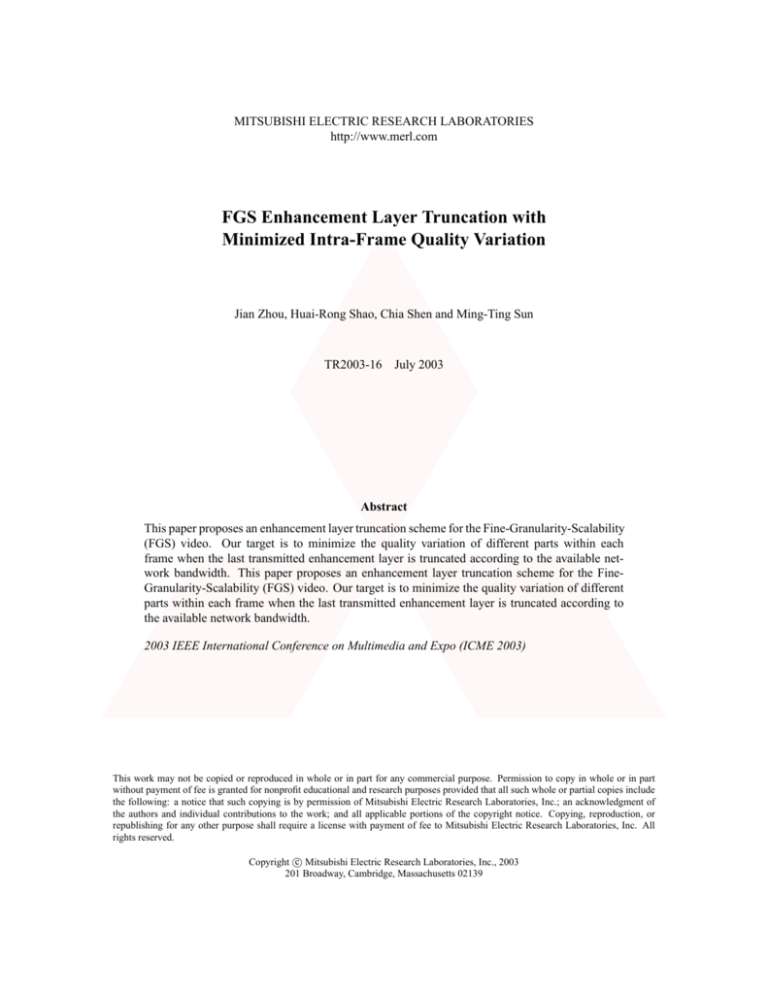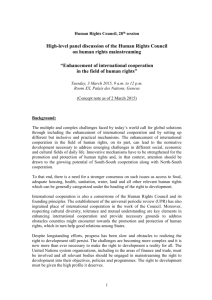
MITSUBISHI ELECTRIC RESEARCH LABORATORIES
http://www.merl.com
FGS Enhancement Layer Truncation with
Minimized Intra-Frame Quality Variation
Jian Zhou, Huai-Rong Shao, Chia Shen and Ming-Ting Sun
TR2003-16
July 2003
Abstract
This paper proposes an enhancement layer truncation scheme for the Fine-Granularity-Scalability
(FGS) video. Our target is to minimize the quality variation of different parts within each
frame when the last transmitted enhancement layer is truncated according to the available network bandwidth. This paper proposes an enhancement layer truncation scheme for the FineGranularity-Scalability (FGS) video. Our target is to minimize the quality variation of different
parts within each frame when the last transmitted enhancement layer is truncated according to
the available network bandwidth.
2003 IEEE International Conference on Multimedia and Expo (ICME 2003)
This work may not be copied or reproduced in whole or in part for any commercial purpose. Permission to copy in whole or in part
without payment of fee is granted for nonprofit educational and research purposes provided that all such whole or partial copies include
the following: a notice that such copying is by permission of Mitsubishi Electric Research Laboratories, Inc.; an acknowledgment of
the authors and individual contributions to the work; and all applicable portions of the copyright notice. Copying, reproduction, or
republishing for any other purpose shall require a license with payment of fee to Mitsubishi Electric Research Laboratories, Inc. All
rights reserved.
c Mitsubishi Electric Research Laboratories, Inc., 2003
Copyright 201 Broadway, Cambridge, Massachusetts 02139
MERLCoverPageSide2
FGS ENHANCEMENT LAYER TRUNCATION WITH MINIMIZED INTRA-FRAME
QUALITY VARIATION
Jian Zhou*, Huairong Shao†, Chia Shen† and Ming-Ting Sun*
*Department of Electrical Engineering, University of Washington, Seattle, WA, 98195
†Mitsubishi Electric Research Laboratory, 201 Broadway, Cambridge, MA, 02139
ABSTRACT
This paper proposes an enhancement layer truncation
scheme for the Fine-Granularity-Scalability (FGS) video.
Our target is to minimize the quality variation of different
parts within each frame when the last transmitted
enhancement layer is truncated according to the available
network bandwidth. We propose to redistribute the bits in
the enhancement layer that can only be partially kept with
the available bit-budget so that it is able to cover the
whole frame area to raise the quality of different parts
uniformly. Simulation results confirm the effectiveness of
the proposed method in improving the decoded visual
quality and reducing the intra-frame quality variation.
Keywords: Fine Granularity Scalability, constant quality,
enhancement layer truncation.
1. INTRODUCTION
For today’s Internet video streaming applications, one
important concern is to intelligently deliver compressed
video streams to the end-users with heterogeneous
environments. Fine Granularity Scalability (FGS) [1] has
been adopted as an amendment to the MPEG-4 standard to
address this concern.
The FGS encoder generates two bit streams: one is the
base-layer stream to provide the basic visual quality, and
the other is the enhancement-layer stream to improve the
base-layer quality. The enhancement-layer stream is
encoded into several layers with bit-plane coding [2]
scheme, and this enables FGS to provide continuous ratecontrol, in that the enhancement layers can be truncated at
any point to achieve the target bit-rate. The corresponded
quality of the reconstructed frames is proportional to the
amount of enhancement-layer bits received. However, the
standard does not specify how to truncate the
enhancement layers; it only specifies how to decode the
truncated bit stream.
Some research efforts have been introduced on how to
truncate the FGS enhancement-layer bit-stream. One
simple method, called “even truncation”, evenly allocates
the available bit-budget to each enhancement-layer frame
[3]. This scheme has two defects. (1) The decoded visual
quality varies from frame to frame, since the complexity
of every frame may be different. We call it inter-frame
quality variation. (2) The quality of different parts in a
same frame also varies from place to place, since the
truncated enhancement layer only covers partial frame
area. We call this intra-frame quality variation.
In order to solve the first problem, Zhao [4] uses the
nearest feather line to evaluate the importance of each
frame, and allocate bits to the enhancement-layer by this
criterion. Zhang [5] and Zhao [6] propose to use the
optimal rate allocation to truncate the enhancement-layer
bit-stream, where the rate-distortion (R-D) curves for each
enhancement-layer frame are interpolated during the
encoding time to determine the amount of bits that should
be truncated. This algorithm minimizes inter-frame quality
variation. However, none of the schemes mentioned above
has considered the intra-frame quality variation.
For the second defect, Cheong [7] uses water-ring scan
order together with selective enhancement to transmit the
bit-planes in the area of interest. However, the decoder
needs to be modified to decode the water-ring scanned
enhancement layers. Another problem is that, for many
video sequences with natural scenes, it is hard to define
the area of interest, or there might be more than one area
of interest. Lim [8] proposes to re-order the enhancementlayer macroblocks according to the quantization values
and the coded DCT coefficients of corresponding baselayer macroblock. However, this method does not solve
the non-uniform quality in the frame when the
enhancement layer is truncated, and the decoder also
needs to be modified to decode the enhancement layer.
In this paper, we propose a standard-compatible scheme to
reduce the intra-frame quality variation, where the last
enhancement layer that can be transmitted for each frame
is encoded using the available bit -budget so that it can
cover the whole frame area to raise the quality of different
parts uniformly. Simulation result confirms the
effectiveness of the proposed method.
The rest of the paper is organized as follows. Section 2
presents our enhancement-layer truncation approach.
Simulation results are shown in Section 3, and the
conclusion is drawn in Section 4.
2.
PROPOSED SCHEME
2.1 Problem Statement
The current MPEG-4 FGS uses a normal scan order to
encode the enhancement-layer macroblocks from the
upper-left corner down to the bottom-right corner in a
frame. As a result, the last bit-plane (layer) of will usually
cover part of the frame after the truncation. This is shown
in Figure 1. At the decoder side, the upper part covered by
the transmitted bit-plane will be enhanced, and the lower
part of the frame will not get the enhanced quality, thus
the intra-frame quality variation arises.
Obviously, if the last bit-plane to be transmitted can cover
the whole frame, the quality of the whole frame can be
enhanced uniformly. However, the channel bandwidth is
often not wide enough to transmit the whole bit-plane.
We solve the above problem by re-encoding the last bitplane for each frame. Compared with the original last bitplane, each transcoded block has fewer bits than the
original one, but the total amount of bits of the last bitplane will be the same as the original one. The effect is
that, the transmitted bit stream is now able to cover the
whole frame area, thus the quality of every block will be
uniformly enhanced. The whole process to transcode the
enhancement layer of one frame is explained below:
1. Encode the current bit-plane as described in the
standard, record the amount of bits generated by each
block as Ri where i = 0,1,...N − 1 , ( N is the number
of block in the frame) and the total amount of bits
RBP for the whole bit-plane.
2. If bandwidth allowed, transmit the current bit-plane and
go to step 1 to encode the next bit-plane.
3. If not, it means the remaining bit-budget RBudget will
not be enough for the whole bit-plane, then the
following steps are taken to reduce the number of bits
generated in the bit-plane:
• Shrink the bit budget for each block as:
Ri
N
∑R
i =1
where
× ( RBP − RBudget )
(1)
i
Ri' is the new bit-budget to encoder each
block. Equation 1 indicates the over-shot bit budget
( R BP − RBudget ) is allocated to each block by its
original bits contribution to the whole frame.
bit-budget
Ri' is met. Each enhancement layer block
have 64 bits, either “0” or “1”, corresponding to the
residual errors of DC coefficient to the highest AC
coefficients. The encoding procedure with new bit
budget means some of the “1” applied to enhance the
high frequency DCT coefficients will be dropped.
• Process the next block until the end of the frame.
Our proposed scheme can be combined with other
algorithms aiming at reducing the inter-frame quality
variation, such as [5], so that both the inter-frame and the
intra-frame quality variation can be reduced. This scheme
is fully standard compatible, and it only introduces a small
portion of extra processing on the enhancement layer, and
it can be realized in real-time.
2.3 Rate-Distortion Optimization
2.2 Enhancement Layer Truncation
Ri' = Ri −
• Re-encode the symbols in each block until the new
In the proposed enhancement layer truncation scheme
above, what we do is to drop the “1” bits in the
enhancement layer block from which corresponds to the
highest AC frequency in the DCT domain. Yet this
scheme is not optimized from the rate-distortion point of
view. For example, assume the first two consecutive
coefficients, 8 and 15, will be encoded in the enhancement
layer block, and they can be represented as “1000” and
“1111” in the binary form. The MSB, or the first
enhancement layer contains two “1”. Suppose part of the
MSB can be transmitted. If we decide to transmit the bit
“1” corresponds to “8”, the overall distortion will be 225
in terms of sum of square difference (SSD), while if to
transmit the bit “1” corresponds to “15”, the overall
distortion will be as large as 113 in terms of SSD. On the
other hand, to erase the bit “1” related to “15” will
generate fewer bits to encode the MSB compared with
only erasing the “1” related to “8”. So, some balance
should be made to decide which “1” bits in the current
block should be erased, or, not to be transmitted. The
enhancement layer transcoding problem can be
generalized as to select some “1” bits from the original
block so that the encoded bit-stream will conform to the
restricted bit-budget and offer an optimized quality.
Joint rate-distortion optimization method can be utilized to
solve this problem. If every block is optimized, then the
whole frame is optimized [9]. In one block, for a certain
λ , we can minimize the cost function of
J (λ ) = D (R i ) + λR i , where Ri is the number of bits used
to encode the current block, and D(R i ) is the distortion
corresponded to the rate of Ri . As we have mentioned
above, when we compute the distortion occurred by
erasing the bit “1” in the current bit-plane, the bits
associated with the same DCT coefficient in the higher
enhancement layer should also be taken into
consideration.
In one enhancement layer block, there’re 64 bits in one
bit-plane. To save the computation, we only consider if
the “1” bits will be encoded or erased. The combination of
the available erasure pattern will be exponential to the
number of “1” in the current block. We can process this
using the trellis search method:
000000000000001000000000000000000001. . .
λ R2
λ R1
A
B
D
λ R3+D
C
E
• A is the starting of the bit-plane.
• When it reaches the 1st “1” in the bit plane, there’re two
ways to deal with it, either to keep it as “1” or to modify
it as “0”, thus two states are generated, namely, “B” and
“C”. For route “A-B”, a cost function can be calculated
as J = λR1 , where R1 is the length of the code word to
describe the bit string so far. For route “A-C”, no cost
function is available yet.
• When it reaches the 2nd “1” in the bit plane, 4 routes
are generated, namely, “BD”, “CD”, “BE”, “CE”. State
“E” indicates that this “1” is modified as “0”, and state
“D” indicates the “1” is kept. For the two routes
entering the state “D”, one should be discarded,
according to the value of λ ( R1 + R2 ) (corresponding to
the route ABD) and λR3 + D (corresponding to the
route ACD), where R3 is the length of the code word to
describe the string of “ACD”, and D is the distortion
incurred by changing the “1” in position “B” to “0”.
One important issue is how to find an approriate λ for the
whole frame, so that the generated rate can meet the
budget. This can be solved using iteration approaches ,
such as described in [10]. Another issue is that, according
to our observation, the λ value in the consecutive frames
are quite similar, thus we can use the λ in the previous
frame as the initial λ in the current frame, and this will
reduce the computation due to the iterations.
3. SIMULATION RESULT
To validate the effectiveness of our approach, we encoded
the Akiyo sequence (CIF format) and compare the
performance of “even truncation” with our methods for
the enhancement layer. The base-layer is encoded with the
quantization parameter of Q = 31 for both I frames and P
frames. There is no B frame in the sequence. The total
available bandwidth for the enhancement layer is 576
kb/s.
Figure 2 shows the PSNR improvement for each frame
obtained from our bit-plane truncation algorithm
compared with the even truncation algorithm. For the
whole sequence, our algorithm which simply drop the “1”
bits, as described in Section 2.2, can obtain an average of
0.17 dB improvement. After the R-D optimization, an
average imp rovement of 0.48 dB can be achieved. We use
the variance of each macroblock’s mean square error
(MSE) for the luminance component to measure the intraframe quality variation. Figure 3 illustrates the intra-frame
quality variation for each frame (left) and the deduction of
the quality variance (right). Since our method can improve
the quality of each block uniformly, for the Akiyo
sequence, it reduces the intra-frame quality variation by
26% if we simply drop some “1” bits, and 38% after R-D
optimization. Figure 4 shows the decoded frame 61 by
even and R-D optimized truncation algorithms. It can be
seen that our algorithm has better subjective visual
quality.
4. SUMMARY
In this paper, we studied the rate adaptation problem for
the FGS enhancement-layers. Specially, we proposed a
standard-compatible method that can redistribute the
available bit-budget for the last transmitted bit-plane to
each block, so that the whole frame can be more
uniformly enhanced and the intra-frame quality variation
can be reduced. Simulation result proves the effectiveness
of the proposed algorithm.
5. REFERENCES
[1]
[2]
[3]
[4]
[5]
[6]
[7]
Coding of Audio-Visual Objects – part2 Visual –
Amendment 2: Streaming Video Profiles, ISO/IEC
214496-2: 2001 / Amd 2: 2002
W. Li, “Bit-Plane Coding of DCT Coefficients for Fine
Granularity Scalability,” ISO/IEC JTC1/SC29/WG11,
MPEG98/M3989, Oct. 1998.
M. van der Schaar and H.Radha, “A Hybrid TemporalSNR Fine Granular Scalability for Internet Video”, IEEE
Trans. on Circuits and System for Video Technology,
Vol. 11, No. 3, March 2001, pp. 318-331
L. Zhao, Q. Wang, S. Yang and Y. Zhong, “A Contentbased Selective Enhancement Layer Dropping Algorithm
for FGS Streaming Using Nearest Feather Line Method”,
Visual Communications and Image Processing 2002,
Proceedings of SPIE, Vol. 4671, pp. 242-249
X.Zhang, A. Vetro, Y. Shi and H. Sun, “Constant
Quality Constrained Rate Allocation for FGS Video
Coded Bitstreams”, Visual Communications and Image
Processing 2002, Proceedings of SPIE, Vol. 4671, pp.
817-827
L. Zhao, J. Kim and C. Kuo, “MPEG-4 FGS Video
Streaming with Constant-Quality Rate Control and
Differentiated Forwarding”, Visual Communications and
Image Processing 2002, Proceedings of SPIE, Vol. 4671
W. Cheong, K. Kim, G. Park, Y. Lim, Y. Lee and J.
Kim, “FGS coding scheme with arbitrary water ring scan
order”,
ISO/IEC
JTC1/SC29/WG11,
MPEG
2001/m7442, Sydney, July, 2001.
[8]
C. Lim and T. Tan, “Macroblock reordering for FGS”,
ISO/IEC JTC1/SC29/WG11, MPEG 2000/m5759,
March, 2000.
A. Ortega and K. Ramchandran, “Rate-Distortion
Methods for Image and Video Compression”, IEEE
Signal Processing Magazine, Nov. 1998, pp 23-50
Y. Shoham and A. Gersho, “Efficient Bit Allocation for
an Arbitrary Set of Quantizers”, IEEE Trans. on ASSP,
vol.36, No.9, Sept. 1998, pp1445-1453
[9]
[10]
The Macroblock that can be transmitted
The Macroblock that will be truncated
Figure 1– Effect of FGS enhancement layer bit-plane
truncation with normal scan order
PSNR Gai n
0.8
145
127
91
0
109
281
241
201
161
121
81
1
41
0.2
73
RD-Opt
55
35
34.5
Drop "1"
RD- Opt
0.4
37
Drop "1"
35.5
0.6
19
Even
36
1
36.5
PSNR difference
(dB)
PSNR (dB)
PSNR of the decoded frame
f r a me No.
Frame No.
Figure 2– PSNR for each frame (left) and PSNR improvement (right) for each frame in the Akiyo sequence
I n t r a - f r a me qual i t y v a r r e d u c t i o n
Frame No.
283
236
189
142
95
274
235
196
157
118
79
40
RD-Opt
Drop "1"
RD_Opt
48
Drop "1"
60
50
40
30
20
10
1
Even
ratio (%)
700
600
500
400
300
200
1
quality var.
Intra-frame quality variation
f r a me No.
Figure 3– Intra-frame quality variance (left) and variation deduction (right) for each frame in the Akiyo sequence
Figure 4– Subjective quality of the decoded frame 61 from even truncation (left) and R-D optimization (right)









